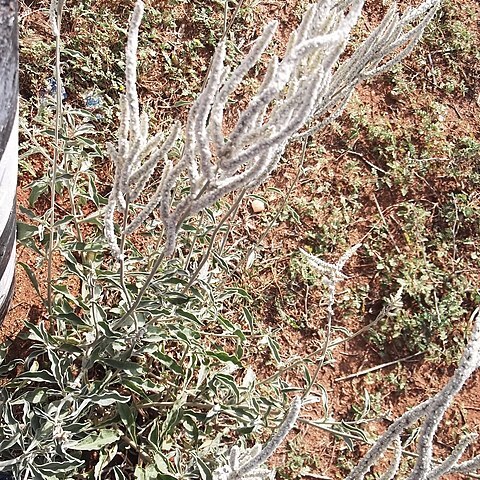Herbs or subshrubs. Stem erect, stoloniferous or climbing. Leaves alternate or opposite, margin entire. Flowers perfect, unisexual or dioecious, small or very small. Inflorescences spikes, terminal or axillary, simple or in complex thyrsoid structures. Bracts and bracteoles membranous, persistent or bracteoles falling off with perianth in fruit. Tepals 4 or 5, ovate or oblong, membranous or papery, lanose, with only 1 vein. Stamens 4 or 5; filaments subulate, unequal, united to short cup at base, alternating with pseudostaminodes, pseudostaminodes subulate to oblong; anthers 2-loculed. Ovary obovoid or subglobose, glabrous; style persistent; stigmas 2, capitate. Utricles ovoid, compressed, membranous, indehiscent or irregularly dehiscent (bursting), falling off with perianth. Seeds reniform-orbicular, lenticular, compressed.
Herbs or undershrubs, erect, straggling or clambering. Leaves alternate or opposite, quite entire. Flowers in axillary and terminal spikes, small ☿ or (☿)(♀), solitary in the axil of a persistent bract, sustended by 2 bracteoles: the latter either falling off with the perianth or not; rachis of the spike remaining whole after fruiting, or breaking up. Tepals 5, free, thin and tender or rather firm, hairy, 1-or more-nerved. Stamens 5; filaments at base connate in a short cup; free parts subulate, alternating with shorter, subulate, pseudo-staminodes; anthers 2-celled (4-locellate). Ovary compressed, glabrous; ovule 1, pendent from apex of long funicle; style very short, stigmas 1-2. Utricle falling off with the perianth, much compressed, bursting irregularly. Seed vertical, reniform, shining black.
Herbs, perennial, prostrate to erect or scandent. Leaves opposite or alternate, entire. Inflorescence of terminal and axillary, sessile or pedunculate, simple or branched spikes, many-flowered. Bracts and bracteoles persistent, membranous. Flowers solitary, sessile, bisexual or dioecious. Tepals 5, falling with mature fruit. Stamens 5; filaments united in a short cup around the ovary; staminodes 0; pseudostaminodes 5, alternating with free filaments; anthers bilocular. Ovary: ovule 1; style very short or long; stigmas 2, short to long, filiform. Fruit a membranous indehiscent utricle. Seed 1, black, shiny.
Ovary with a single pendulous ovule; style very short to slender and distinct; stigmas 2, short to long and filiform (sometimes solitary and capitate, flowers then probably functionally male).
Flowers hermaphrodite or dioecious, sometimes probably polygamous, bibracteolate, in axillary and terminal sessile or pedunculate bracteate spikes, one flower in the axil of each bract.
Perianth segments 5, oval, or lanceolate-oblong, membranous margined with a thin to wider green centre, the perianth deciduous with the fruit but bracts and bracteoles persistent.
Stamens 5, shortly monadelphous at the base, alternating with subulate or rarely narrowly oblong and truncate or emarginate pseudostaminodes; anthers bilocular.
Perennial herbs (sometimes flowering in the first year), prostrate to erect or scandent.
Leaves and branches opposite or alternate, leaves entire.
Capsule thin-walled, bursting irregularly.
Seed compressed-reniform, firm, black.

